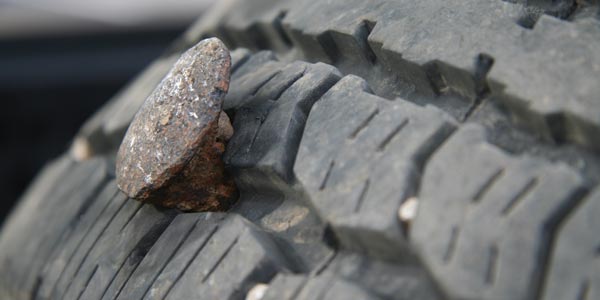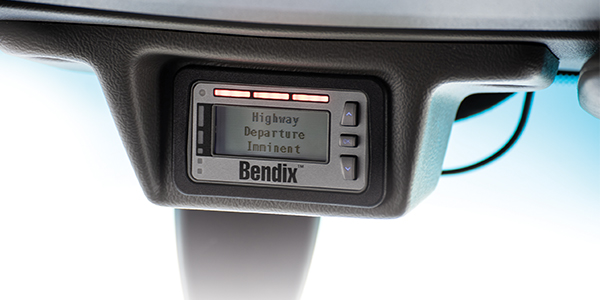Ride comfort and enhanced cargo protection continue to drive the popularity of air suspension systems on tractors and trailers. Today, air suspensions are specified on 85% to 90% of all new on-highway commercial vehicles in North America.
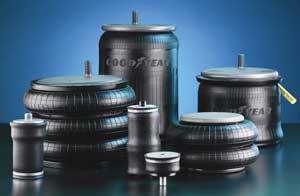
“Given the broad range of benefits that air suspensions provide, they add value in all types of truck and trailer applications,” says Dave Vanette, manager of new business development at Firestone Industrial Products Co. “Overall, air suspensions reduce the amount of wear and tear on tractors and trailers and contribute to longer vehicle life, lower operating costs and providing less downtime. Air suspensions also enhance driver comfort.”
Russ Franks, field service manager at Meritor, points out that air-ride suspension models typically are specified on trailers to meet particular application requirements. “Ride height is one component of each model’s design,” he says, “and because of differing air suspension designs, when air springs need to be replaced, they must be replaced with identical components recommended by the original equipment suspension manufacturer. They are designed for specific articulation and rotation capabilities, which can be compromised by improper installation.”
“Care must be taken to ensure the correct loaded suspension ride height is maintained while the trailer is in use,” says Howard Adkins, manager of technical services at Hendrickson Trailer Commercial Vehicle Systems. “Ride height is calculated by subtracting the loaded tire radius from the loaded frame-to-ground height. The radius of the tire will decrease as the trailer is loaded due to tire deflection, which in turn affects the trailer deck height.”
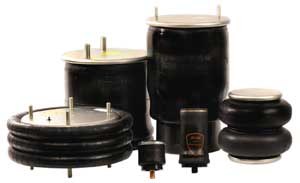
Adkins also notes that tractor 5th wheel height affects the height of the trailer frame, so variations in 5th wheel height will result in variations of suspension ride height. Other factors to consider when spec’ing air suspensions on trailers include deflection of the trailer frame when loaded, which results in a suspension ride height different from the installed ride height. In addition, the trailer’s tire clearance must be used to determine the maximum suspension jounce permitted and provide sufficient clearance to allow for tire distortion and axle walk.
Air spring compatibility
Different types of air springs are used on vehicle suspensions, including convoluted and rolling lobe designs, notes Mike Edlund, application engineer at SAF Holland. “Shocks control the suspension’s down travel,” he explains. “They will be at full extension before the air spring fully extends. Air springs and shocks are meant to be compatible. That’s why in the aftermarket, it is critical to use the correct part as a replacement or you could have performance and/or suspension component problems.”
Air springs can appear to be similar in design and size at first glance, relates John Healy, heavy duty marketing manager at Veyance Technologies, manufacturer of Goodyear Engineered Products. “Differences in manufacturing techniques used for similar-looking air springs may create substantial differences in operating dimensions,” he says. “Specifically, the inflated or operating diameters of seemingly identical air springs will vary depending on the angle of the reinforcing fabric used in the flexible member.”
Veyance offers a step-by-step procedure for identifying air springs:
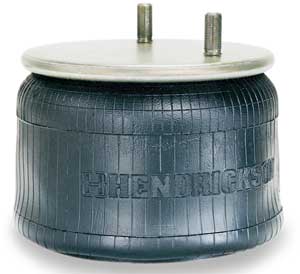
1. Start with the original equipment or aftermarket part number. It usually is located on a label affixed to the top plate of the air spring.
2. If the O.E. part number or aftermarket part number is unknown, you should begin your search with the bellows number. The number is molded into the rubber part of the air spring.
3. Measure the width of the top plate and make a note of the bolt pattern or taps.
4. Measure the width of the piston or bottom bead plate and make a note how the bolt pattern is oriented compared to the bolts on the top plate (Inline or Rotated).
5. Measure the height of the air spring with no air pressure from the top plate to the bottom of the piston. This is the extended height.
6. Compress the bag as far as possible with no air pressure and measure the height. This is the compressed height, or minimum height.
7. Measure the distance from center to center of each bolt on the top and bottom of the air spring.
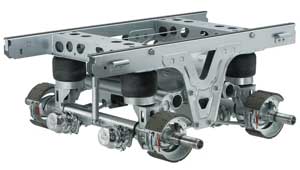
Dan Kaiser, product development and technical services at Triangle Suspension Systems, says the company recently established WebSST (websst.triangleusa.com), a specially-designed website that allows users to identify and search for the correct replacement air springs for tractor and trailer suspensions. The site, which enables a progressive search by a variety of parameters, including vehicle makes and models as well as system dimensions, is especially useful when looking for suspension components.
Good service life
“Air springs usually have a very good service life,” Kaiser says. “Road hazards are the biggest issues, followed by worn suspension components or misaligned axles. Proper inspection, service and repair of the entire system are important for safe and reliable operation of any system.”
Early detection and correction of problems with air suspensions can lower maintenance expenses and prolong trailer life, notes Hendrickson’s Adkins. “Air springs can last almost indefinitely in most applications,” he says. “However, air springs will fail quickly when rubbed, scuffed or punctured. If an air spring fails, you should try to determine the cause of the failure so you can avoid a costly repeat of the problem. By correcting minor problems, air suspensions will provide excellent service throughout a trailer’s life.”
Hendrickson also advises daily inspections of trailer air suspensions to verify a level trailer is riding at the correct ride height. This inspection will reveal obvious problems and a closer look can detect broken or loose parts before any serious problems appear. More detailed inspections are recommended at 30- and 90-day intervals to ensure proper clearance around air springs, that bolts are secure, axle connections are tight and there are no obvious signs of wear.
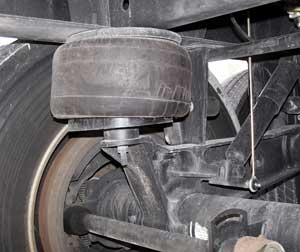
Meritor’s Franks notes items to consider for properly maintaining air springs. “When maintaining air-ride suspensions, it is critical that the height control valve is checked, cleaned and reset if necessary to maintain ride height within the specification in the manufacturer’s service manual,” he relates. “All air suspensions are designed for a particular ride height and should be maintained to stay at that level in order to deliver the expected benefits.
An air spring not at the proper height also can cause pinching or folding of the rubber sleeve, which will also compromise the load-carrying benefits of the air suspension, Franks points out. The outside diameter of the piston should be checked regularly and cleared of any foreign material, especially in fleets operating in environments where air springs are particularly susceptible to damage from debris entering and accumulating in this area.
Full benefits
“Fleet operations that see their trailers on a regular basis typically maintain the proper height because they are checked during routine maintenance,” Franks says. “However, some long-haul, over-the-road vehicles don’t necessarily get this check often enough, which can result in air-ride trailers running without the full benefits of air for the loads they are carrying.”
Advice from Edlund at SAF Holland includes proper cleaning methods to keep air springs in top shape. “We ask that fleets use soap and water to clean the air springs and keep the lower base or piston free of debris so a rough spot wearing on the rubber doesn’t develop,” he says. “We’ve seen situations where customers have used cleaners or detergents on air springs that can accelerate wear. Some of these products will dry out the air spring and give it the appearance of aging.”
| Resources |
| Firestone Industrial Products Co. – www.firestoneindustrial.com Hendrickson Trailer Commercial Vehicle Systems – www.hendrickson-intl.com Meritor – www.meritor.com SAF Holland – www.safholland.com Triangle Suspension Systems – www.triangleusa.com Veyance Technologies – www.veyance.com |
SAF Holland recommends in-service inspections of air suspensions because “an improperly set ride height could result in suspension component damage and/or poor vehicle ride performance.” On a daily basis, the company advises a visual inspection of the air springs for sufficient and equal pressure and to see that suspension is set at the proper ride height. Other routine items on the manufacturer’s list at various intervals include inspections of bolts and nuts at the pivot and axle connections to ensure they are properly torqued, as well as inspections of air control system fittings for leaks. Also, check all other suspension components for any sign of damage, looseness, torque loss, wear or cracks.
“The vast majority of premature air spring failures are caused by other problems associated with the suspension system,” says Vanette at Firestone Industrial Products. “The wear and tear of road travel can take its toll on the components of the suspension system, for instance, causing certain malfunctions. Air lines may break loose and rub against air springs, causing abrasions or tears in the rubber bellows.
Bushings may wear out and cause similar damage due to misalignment of the air spring. The most common problem is overextension of the air spring, typically caused by a broken shock absorber that allows the air spring to travel too far and tears the air spring apart.”
As with all components and systems, routine preventive maintenance of air springs is one of the best ways to guarantee maximum life and performance. Properly maintained air suspensions provide cargo protection and a more comfortable ride, as well as lower maintenance costs.
Air suspension maintenance checklist
Air suspension systems require a minimal amount of maintenance that can be performed during routine service intervals. Fleets should follow maintenance recommendations of air spring and suspension system manufacturers. Veyance Technologies provides the following checklist as a guide to routine air suspension maintenance:
* Check air lines and fittings for leaks and/or rubbing on air spring.
* Check proper clearance around air springs when inflated. Generally, a minimum of 1.5-in. will allow for the increased diameter, which occurs in heavy jounce.
* Periodically, check suspension for proper ride height. This dimension should be maintained +/- 1/4-in. to protect the springs and shocks from overextension or frequent bottoming out of the suspension.
* During routine vehicle maintenance, block up the suspension and check for irregular wear or material build-up on the flexmember. Clean, if necessary, using a non-petroleum-based cleaning solution.
* Check rolling lobe pistons for material build-up. Hardened debris on the piston will shorten spring life and should be removed as part of regular maintenance.
* Check shock absorbers for any signs of leaking hydraulic fluid, broken end connections, worn bushings or cylinders, and overextension.
* Periodically, check nuts and bolts for proper torque. See manufacturer’s manual for specific recommendations.
* Check height control valve to see that it is functioning properly. Clean or replace, if necessary. A properly-maintained valve will save hundreds of dollars in unneeded maintenance expenses.












